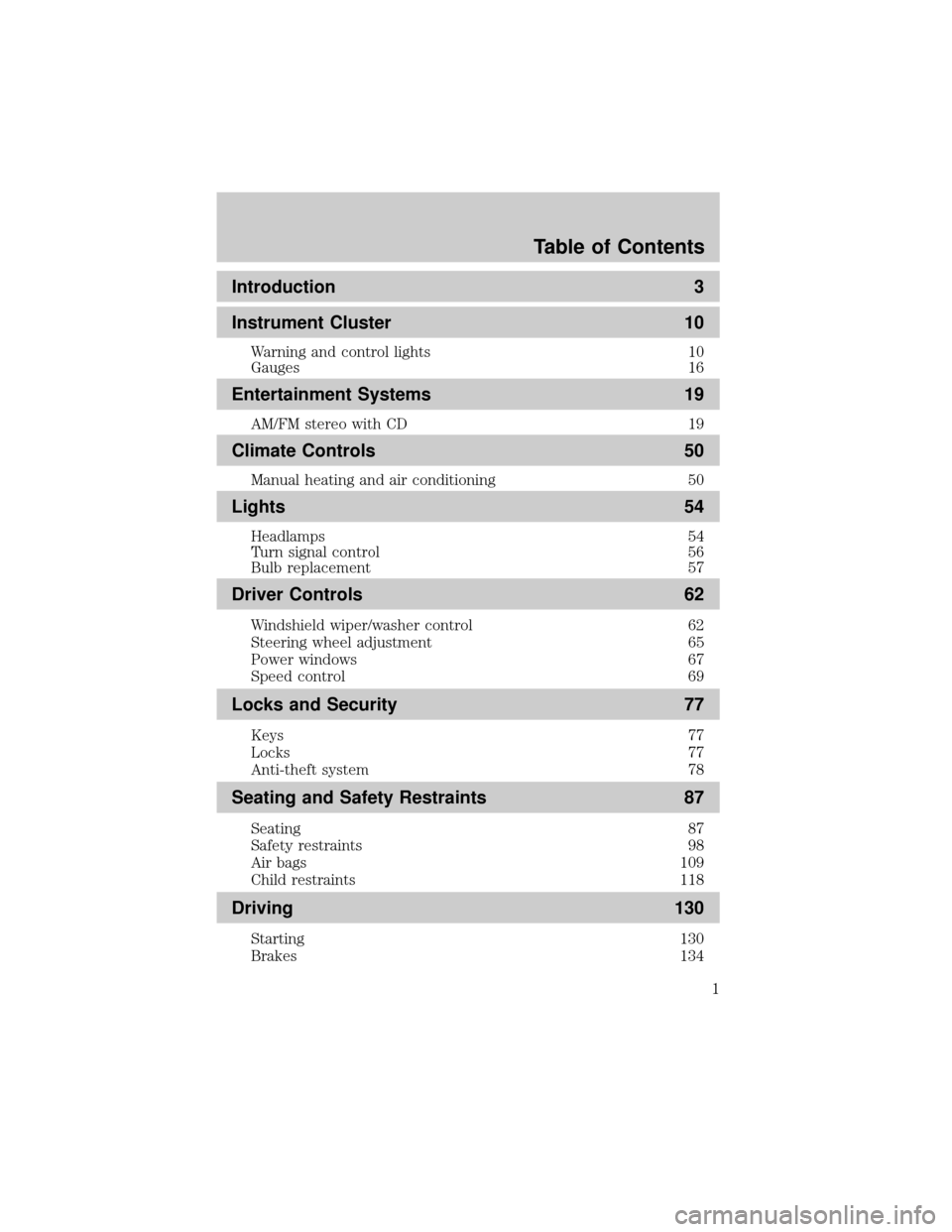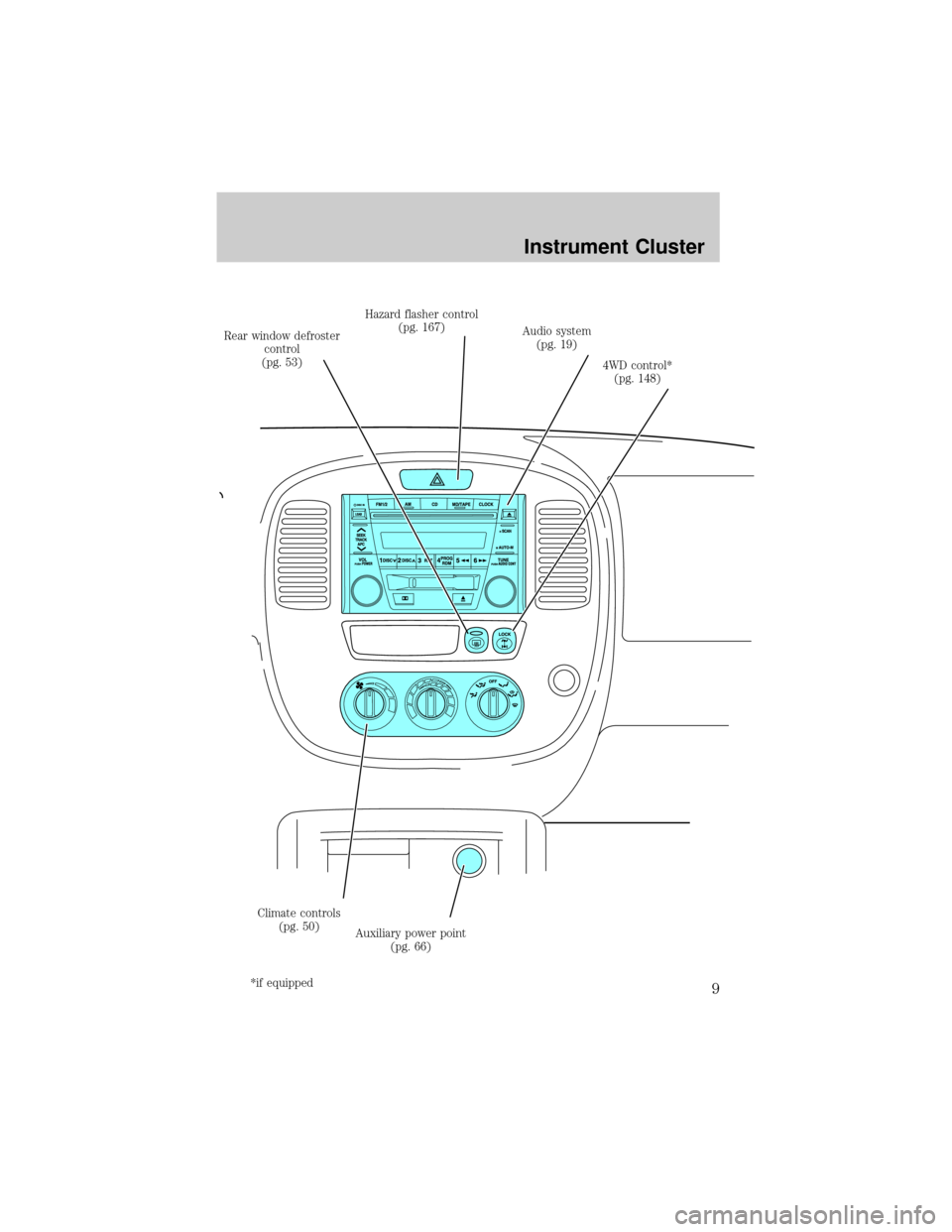climate control MAZDA MODEL TRIBUTE 2002 Owners Manual (in English)
[x] Cancel search | Manufacturer: MAZDA, Model Year: 2002, Model line: MODEL TRIBUTE, Model: MAZDA MODEL TRIBUTE 2002Pages: 256, PDF Size: 2.66 MB
Page 1 of 256

Introduction 3
Instrument Cluster 10
Warning and control lights 10
Gauges 16
Entertainment Systems 19
AM/FM stereo with CD 19
Climate Controls 50
Manual heating and air conditioning 50
Lights 54
Headlamps 54
Turn signal control 56
Bulb replacement 57
Driver Controls 62
Windshield wiper/washer control 62
Steering wheel adjustment 65
Power windows 67
Speed control 69
Locks and Security 77
Keys 77
Locks 77
Anti-theft system 78
Seating and Safety Restraints 87
Seating 87
Safety restraints 98
Air bags 109
Child restraints 118
Driving 130
Starting 130
Brakes 134
Table of Contents
1
Page 9 of 256

Audio system
(pg. 19)
4WD control*
(pg. 148)
Climate controls
(pg. 50)
Auxiliary power point
(pg. 66) Rear window defroster
control
(pg. 53)Hazard flasher control
(pg. 167)
*if equipped
Instrument Cluster
9
Page 50 of 256

MANUAL HEATING AND AIR CONDITIONING SYSTEM
Fan speed control
Controls the volume of air circulated
in the vehicle.
Temperature control knob
Controls the temperature of the
airflow inside the vehicle.
Mode selector control
Controls the direction of the airflow
to the inside of the vehicle.
The air conditioning compressor will operate in all modes
except
,, and. However, the air conditioning will only
function if the outside temperature is about 6ÉC (43ÉF) or higher.
Since the air conditioner removes considerable moisture from the air
during operation, it is normal if clear water drips on the ground under
the air conditioner drain while the system is working and even after you
have stopped the vehicle.
Under normal conditions, your vehicle's climate control system should be
left in any position other than MAX A/C or OFF when the vehicle is
parked. This allows the vehicle to ªbreatheº through the outside air inlet
duct.
A/COFFMAX
A/C
A/COFFMAX
A/C
Climate Controls
50
Page 51 of 256

NOTE:In snowy or dirty conditions, leave the mode selector in the OFF
position.
²MAX A/C- Uses recirculated air to cool the vehicle. MAX A/C is noisier
than A/C but more economical and will cool the inside of the vehicle
faster. Airflow will be from the instrument panel registers. This mode
can also be used to prevent undesirable odors from entering the
vehicle.
²A/C-Uses outside air to cool the vehicle. It is quieter than MAX A/C
but not as economical. Airflow will be from the instrument panel
registers.
²
(Panel)-Distributes outside air through the instrument panel
registers. However, the air will not be cooled below the outside
temperature because the air conditioning does not operate in this
mode.
²OFF-Outside air is shut out and the fan will not operate. For short
periods of time only, use this mode to prevent undesirable odors from
entering the vehicle.
²
(Panel and floor)-Distributes outside air through the instrument
panel registers and the floor ducts. Heating capabilities are provided in
this mode. For added customer comfort, when the temperature
control knob is anywhere in between the full hot and full cold
positions, the air distributed through the floor ducts will be slightly
warmer than the air sent to the instrument panel registers. However,
the air will not be cooled below the outside temperature because the
air conditioning does not operate in this mode.
²
(Floor)-Allows for maximum heating by distributing outside air
through the floor ducts. However, the air will not be cooled below the
outside temperature because the air conditioning does not operate in
this mode.
²
(Floor and defrost)-Distributes outside air through the windshield
defroster ducts and the floor ducts. Heating and air conditioning
capabilities are provided in this mode. For added customer comfort,
when the temperature control knob is anywhere in between the full
hot and full cold positions, the air distributed through the floor ducts
will be slightly warmer than the air sent to the windshield defrost
ducts. If the temperature is about 6ÉC (43ÉF) or higher, the air
conditioner will automatically dehumidify the air to reduce fogging.
Climate Controls
51
Page 52 of 256

²(Defrost)-Distributes outside air through the windshield defroster
ducts. It can be used to clear ice or fog from the windshield. If the
temperature is about 6ÉC (43ÉF) or higher, the air conditioner will
automatically dehumidify the air to reduce fogging.
Operating tips
²In humid weather conditions, place the climate control system in
Defrost mode before driving. This will reduce fogging on your
windshield. Once the windshield has been cleared, operate the climate
control system as desired.
²To reduce humidity buildup inside the vehicle in cold weather
conditions, don't drive with the climate control system in the OFF or
MAX A/C position.
²To reduce humidity buildup inside the vehicle in warm weather
conditions, don't drive with the climate control system in the OFF
position.
²Under normal weather conditions, your vehicle's climate control
system should be left in any position other than the MAX A/C or OFF
when the vehicle is parked. This allows the vehicle to ªbreatheº
through the outside air inlet duct.
²Under snowy or dirty weather conditions, your vehicle's climate
control system should be left in the OFF position when the vehicle is
parked. This allows the climate control system to be free from
contamination of outside pollutants.
²If your vehicle has been parked with the windows closed during warm
weather conditions, the air conditioner will perform more efficiently in
cooling the vehicle if driven for two or three minutes with the
windows open. This will force most of the hot, stale air out of the
vehicle. Once the vehicle has been ªaired outº, operate the climate
control system as desired.
²Do not put objects under the front seat which may interfere with the
airflow to the rear seats (if equipped).
²Remove any snow, ice or leaves from the air intake area (at the
bottom of the windshield and underneath the hood).
²Do not place objects over the defroster outlets. These objects can
block airflow and reduce visibility through your windshield. Avoid
placing small objects on top of the instrument panel. These objects
may fall down into the defroster outlets and block airflow, in addition
to, damaging the climate control system.
Climate Controls
52
Page 53 of 256

To aid in side window defogging/demisting in cold weather conditions:
1. Select the position that distributes air through the Panel and Floor.
2. Set the temperature control to full heat.
3. Set the fan speed to full fan.
4. Direct the outer panel vents towards the side windows.
5. To increase airflow to the outer panel vents, close the central panel
vents.
WARNING: Do not place objects on top of the instrument panel
as these objects may become projectiles in a collision or sudden
stop.
REAR WINDOW DEFROSTER CONTROL
The rear defroster control is located
on the instrument panel.
Press the rear defroster control to
clear the rear window of thin ice
and fog.
²The small LED will illuminate
when the rear defroster is
activated.
The ignition must be in the ON position to operate the rear window
defroster.
NOTE:The rear defroster does not turn off automatically. Press the
control to turn it off after the screen has been cleared. If the heated rear
screen is still in operation when the ignition is turned off, the heating
function will be reactivated when the ignition is switched on again.
Climate Controls
53
Page 240 of 256

These Tire Quality Grades are determined by standards that the United
States Department of Transportation has set.
Tire Quality Grades apply to new pneumatic tires for use on passenger
cars. They do not apply to deep tread, winter-type snow tires,
space-saver or temporary use spare tires, tires with nominal rim
diameters of 10 to 12 inches or limited production tires as defined in
Title 49 Code of Federal Regulations Part 575.104(c)(2).
U.S. Department of Transportation-Tire quality grades:The U.S.
Department of Transportation requires Mazda to give you the following
information about tire grades exactly as the government has written it.
Treadwear
The treadwear grade is a comparative rating based on the wear rate of
the tire when tested under controlled conditions on a specified
government test course. For example, a tire graded 150 would wear one
and one-half (1 1/2) times as well on the government course as a tire
graded 100. The relative performance of tires depends upon the actual
conditions of their use, however, and may depart significantly from the
norm due to variations in driving habits, service practices, and
differences in road characteristics and climate.
Traction AA A B C
The traction grades, from highest to lowest are AA, A, B, and C. The
grades represent the tire's ability to stop on wet pavement as measured
under controlled conditions on specified government test surfaces of
asphalt and concrete. A tire marked C may have poor traction
performance.
NOTE:The traction grade assigned to this tire is based on
straight-ahead braking traction tests, and does not include acceleration,
cornering, hydroplaning or peak traction characteristics.
Temperature A B C
The temperature grades are A (the highest), B, and C, representing the
tire's resistance to the generation of heat and its ability to dissipate heat
when tested under controlled conditions on a specified indoor laboratory
test wheel. Sustained high temperature can cause the material of the tire
to degenerate and reduce tire life, and excessive temperature can lead to
sudden tire failure. The grade C corresponds to a level of performance
which all passenger car tires must meet under the Federal Motor Vehicle
Safety Standard No. 109. Grades B and A represent higher levels of
performance on the laboratory test wheel than the minimum required by
law.
Maintenance and Specifications
240
Page 243 of 256

WARNING: When replacing full size tires, never mix radial
bias-belted, or bias-type tires. Use only the tire sizes that are
listed on the Certification Label. Make sure that all tires are
the same size, speed rating, and load-carrying capacity. Use only
the tire combinations recommended on the label. If you do not
follow these precautions, your vehicle may not drive properly
and safely and an accident can occur.
WARNING: Make sure that all replacement tires are of the
same size, type, load=carrying capacity and tread (e.g., ªAll
Terrainº, etc.), as originally offered by Mazda. Failure to do so
can result in tire failure and a serious accident.
WARNING: Do not replace your tires with ªhigh performanceº
tires or larger size tires.
WARNING: Failure to follow these precautions may adversely
affect the handling of the vehicle, damage parts of the tire and
make it easier for the driver to lose control and roll over.
Tires that are larger or smaller than your vehicle's original tires may also
affect the accuracy of your speedometer.
USING SNOW TIRES AND TRACTION DEVICES
NOTE:Snow tires must be the same size and grade as the tires you
currently have on your vehicle.
The tires on your vehicle have all-weather treads to provide traction in
rain and snow. However, in some climates, using snow tires and traction
devices may be necessary. If you need to use snow tires and chains, it is
recommended that steel wheels are used of the same size and
specification as those originally installed.
Follow these guidelines when using snow tires and traction devices:
²Do not use tire chains on aluminum wheels. Chains may chip the
wheels.
²Use only SAE Class S chains
²Install chains securely, verifying that the chains do not touch any
wiring, brake lines or fuel lines.
Maintenance and Specifications
243
Page 252 of 256

waxing .....................................198
wheels ......................................199
wiper blades ............................200
woodtone trim ........................201
Climate control (see Air
conditioning or Heating) ............50
Clock ......................................30, 45
Clutch
fluid ..........................................238
operation while driving ..........144
recommended shift speeds ....145
Console ........................................74
overhead ..............................65±66
Controls
power seat .................................89
Coolant
checking and adding ..............219
refill capacities ................223, 244
specifications ..........................246
Cruise control (see Speed
control) ........................................69
Customer
Assistance ..165±166, 188±189, 192
Ford accessories for your
vehicle .....................................202
D
Daytime running lamps
(see Lamps) ................................54
Defrost
rear window ..............................53
Dipstick
automatic transmission
fluid ..........................................236
engine oil .................................213
Doors
door ajar warning .....................14Driving under special
conditions ..........................150, 153
sand .........................................151
snow and ice ...........................154
through water .................152, 157
E
Emergencies, roadside
jump-starting ..........................180
Emission control system ..........232
Engine ........................................247
check engine/service engine
soon light ..................................10
cleaning ...................................199
coolant .....................................219
idle speed control ...................217
lubrication specifications .......246
refill capacities ........................244
service points ..................211±212
starting after a collision .........167
Engine block heater .................133
Engine oil ..................................213
checking and adding ..............213
dipstick ....................................213
filter, specifications ................216
recommendations ...................216
refill capacities ........................244
specifications ..........................246
Exhaust fumes ..........................133
F
Fluid capacities .........................244
Foglamps .....................................55
Four-Wheel Drive vehicles
description ..............................148
driving off road .......................149
indicator light ...................14, 149
Index
252